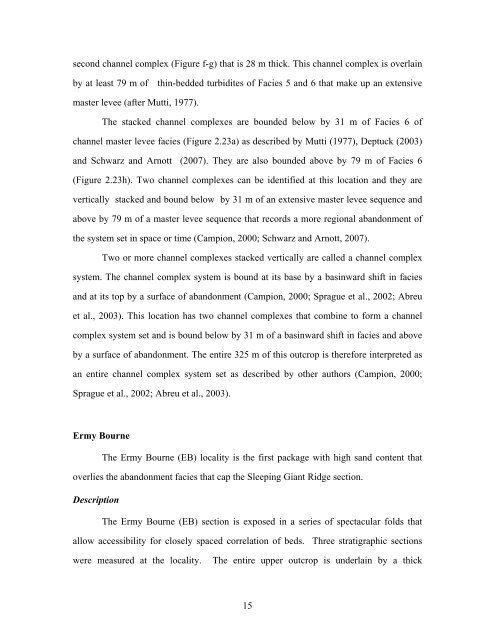Copyright by Nysha Chaderton 2009 - The University of Texas at ...
Copyright by Nysha Chaderton 2009 - The University of Texas at ...
Copyright by Nysha Chaderton 2009 - The University of Texas at ...
Create successful ePaper yourself
Turn your PDF publications into a flip-book with our unique Google optimized e-Paper software.
second channel complex (Figure f-g) th<strong>at</strong> is 28 m thick. This channel complex is overlain<br />
<strong>by</strong> <strong>at</strong> least 79 m <strong>of</strong> thin-bedded turbidites <strong>of</strong> Facies 5 and 6 th<strong>at</strong> make up an extensive<br />
master levee (after Mutti, 1977).<br />
<strong>The</strong> stacked channel complexes are bounded below <strong>by</strong> 31 m <strong>of</strong> Facies 6 <strong>of</strong><br />
channel master levee facies (Figure 2.23a) as described <strong>by</strong> Mutti (1977), Deptuck (2003)<br />
and Schwarz and Arnott (2007). <strong>The</strong>y are also bounded above <strong>by</strong> 79 m <strong>of</strong> Facies 6<br />
(Figure 2.23h). Two channel complexes can be identified <strong>at</strong> this loc<strong>at</strong>ion and they are<br />
vertically stacked and bound below <strong>by</strong> 31 m <strong>of</strong> an extensive master levee sequence and<br />
above <strong>by</strong> 79 m <strong>of</strong> a master levee sequence th<strong>at</strong> records a more regional abandonment <strong>of</strong><br />
the system set in space or time (Campion, 2000; Schwarz and Arnott, 2007).<br />
Two or more channel complexes stacked vertically are called a channel complex<br />
system. <strong>The</strong> channel complex system is bound <strong>at</strong> its base <strong>by</strong> a basinward shift in facies<br />
and <strong>at</strong> its top <strong>by</strong> a surface <strong>of</strong> abandonment (Campion, 2000; Sprague et al., 2002; Abreu<br />
et al., 2003). This loc<strong>at</strong>ion has two channel complexes th<strong>at</strong> combine to form a channel<br />
complex system set and is bound below <strong>by</strong> 31 m <strong>of</strong> a basinward shift in facies and above<br />
<strong>by</strong> a surface <strong>of</strong> abandonment. <strong>The</strong> entire 325 m <strong>of</strong> this outcrop is therefore interpreted as<br />
an entire channel complex system set as described <strong>by</strong> other authors (Campion, 2000;<br />
Sprague et al., 2002; Abreu et al., 2003).<br />
Ermy Bourne<br />
<strong>The</strong> Ermy Bourne (EB) locality is the first package with high sand content th<strong>at</strong><br />
overlies the abandonment facies th<strong>at</strong> cap the Sleeping Giant Ridge section.<br />
Description<br />
<strong>The</strong> Ermy Bourne (EB) section is exposed in a series <strong>of</strong> spectacular folds th<strong>at</strong><br />
allow accessibility for closely spaced correl<strong>at</strong>ion <strong>of</strong> beds. Three str<strong>at</strong>igraphic sections<br />
were measured <strong>at</strong> the locality. <strong>The</strong> entire upper outcrop is underlain <strong>by</strong> a thick<br />
15
















